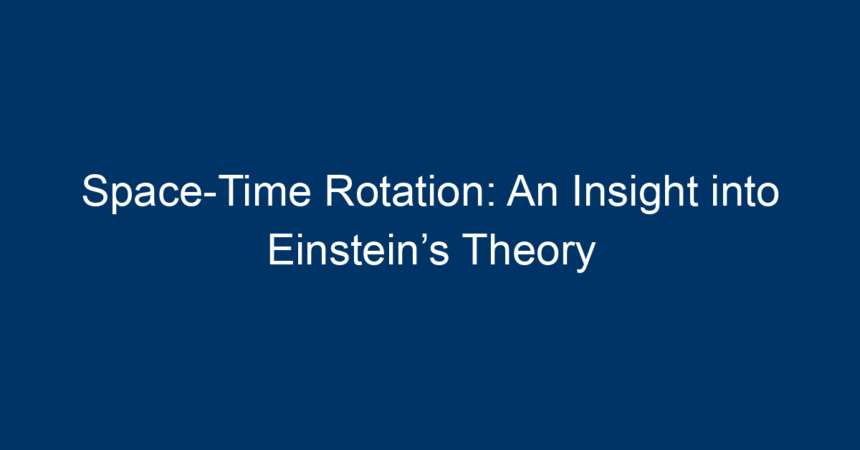Einstein’s theories of relativity have profoundly changed our understanding of the universe, leading to concepts that often appear counterintuitive. One such concept is space-time rotation, which plays a crucial role in both the Special and General Theories of Relativity. But what exactly does space-time rotation entail, and why is it significant? In this article, we will delve deep into the intricacies of space-time rotation, its implications in physics, and how it reshapes our understanding of reality.
What is Space-Time?
Before discussing space-time rotation, it’s essential to clarify what space-time means. In simple terms, space-time is a four-dimensional continuum that combines the three dimensions of space (length, width, height) with the dimension of time. This framework allows physicists to describe events and their relationships in a manner that incorporates both spatial and temporal dimensions.
Einstein’s Breakthrough
When Albert Einstein introduced his theory of relativity, he fundamentally altered the perception of time and space. Instead of viewing them as separate entities, he proposed that they are interwoven. This interdependence leads to the conception of space-time as a fabric that can be warped by mass and energy, a fundamental principle of modern physics.
Understanding Space-Time Rotation
The Concept of Rotation in Space-Time
Space-time rotation refers to the orientation and the dynamics of objects as they move through this four-dimensional continuum. Unlike conventional rotations we understand in three-dimensional space—like a spinning top—space-time rotation involves the bending and twisting of the space-time fabric itself.
Mathematical Framework
To appreciate space-time rotation, one must familiarize oneself with certain mathematical constructs. In Einstein’s field equations, the geometric nature of space-time is represented by tensors. The rotation of space-time can be expressed using these mathematical tools, leading to significant outcomes in theoretical physics. This rotation can substantially impact an object’s perceived acceleration and velocity, thereby affecting time dilation—a phenomenon where time runs differently depending on gravitational strength or velocity.
The Role of Space-Time Rotation in Relativity
In Special Relativity
In the realm of Special Relativity, space-time rotation manifests in scenarios involving high velocities, nearing the speed of light. When objects approach light speed, their mass effectively increases, causing significant gravitational effects on the surrounding space-time. This phenomenon causes time dilation, making observers in different inertial frames perceive time differently.
In General Relativity
General Relativity extends the idea of space-time rotation by incorporating gravitational effects. Here, massive bodies like planets or stars warp the fabric of space-time, resulting in what we perceive as gravity. The curvature created by these masses means that the paths taken by objects in motion are not linear; instead, they are curved around these massive bodies due to the rotation of space-time.
Implications of Space-Time Rotation
Black Holes and Singularities
One of the most fascinating implications of space-time rotation can be observed in black holes. When stars collapse, they create regions of extreme curvature in space-time. The rotation of these black holes can lead to phenomena such as the formation of accretion disks and ergospheres. Inside these regions, the effects of space-time rotation become pronounced, leading to fascinating but complex dynamics.
Time Travel and Hypothetical Constructs
Space-time rotation has also led to speculations about time travel. Theoretical constructs like wormholes or the concept of rotating black holes (Kerr black holes) have raised intriguing questions about possibilities beyond our current understanding of physics. These hypothetical constructs rely heavily on the principles of space-time rotation, pushing the boundaries of theoretical physics.
Space-Time Rotation and Cosmology
In cosmology, space-time rotation provides insights into the evolution of the universe. The Cosmic Microwave Background (CMB) radiation, remnants from the Big Bang, reveals how space-time has been expanding and rotating since the universe’s inception. Understanding this rotation helps us explore concepts like dark energy and the fate of the universe.
Related Phenomena of Space-Time Rotation
Gravitational Waves
Space-time rotation has direct implications for the study of gravitational waves. These ripples in the fabric of space-time, generated by accelerating masses, can carry information about their source. Detecting these waves allows scientists to better understand cosmic events and the nature of space-time rotation itself.
Quantum Mechanics and Space-Time
The intersection of quantum mechanics and space-time rotation is another area of active research. Concepts like quantum entanglement and superposition are being explored in the light of space-time rotation, leading to exciting developments in theoretical physics. Space-time rotation can fundamentally alter our understanding of how particles interact at quantum levels.
Real-world Applications and Technologies
While the theories surrounding space-time rotation are primarily theoretical, they have practical applications that span various fields, including:
-
GPS Technology: Satellites equipped with atomic clocks experience time dilation effects as predicted by relativity. This necessitates adjustments to ensure accurate positioning data.
-
Particle Accelerators: Understanding space-time rotation principles helps physicists design experiments that probe fundamental questions about particles and forces.
- Astrophysics: Space-time rotation principles are crucial for modeling cosmic structures and events, helping scientists predict celestial behaviors.
Conclusion: The Future of Space-Time Rotation Research
Space-time rotation remains one of the most profound concepts stemming from Einstein’s theories. Its implications extend from the very fabric of our universe to the smallest particles in quantum mechanics. As research advances, a deeper understanding of space-time rotation will likely unlock further mysteries of the cosmos.
Actionable Insights
-
Stay Curious: Explore books and documentaries related to Einstein’s theories, quantum mechanics, and cosmology to gain a better understanding of the universe.
-
Push the Boundaries: For students and aspiring physicists, diving into advanced mathematics can provide the tools needed to unravel more complexities of space-time.
-
Engage with Community: Join online forums, attend lectures, or participate in local science discussions to exchange ideas and stay updated on the latest research in space-time.
- Advocate for Science: Encourage science education and literacy in local communities. Understanding the principles of space-time could spark the next generation of scientists and researchers.
By embracing the wonders of space-time rotation, we not only honor Einstein’s legacy but also continue our own quest for knowledge and understanding of the universe.




